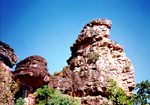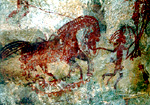


|
|

|
|
| HOME | TRAVEL | TRAVELOG | |||
 The Caveman's Easel
The Caveman's Easel
... Bhimbetka in Madhya Pradesh
Text and photographs: Vaihayasi P Daniel
Most of the cave paintings are quite faint. One can hardly suppose the reds and whites to be fresh 10,000 years later. However, that does not detract from the fact that the subject of each etching is extremely clear.
Those in red are dated at 8000 BC. And the striped outlines are just 2,000 years old. So says Krishna who picked up his facts from Archaeological Survey of India archaeologists who worked at the site for a decade or more.
According to the information available at the site, the cavemen probably used brushes made from twigs to execute their work. The colours available were extremely limited. Red and white was the norm. Yellow and green colours are apparent in a few caves. But these colours were probably not as durable as the standard red or white because the flowers and other subjects etched in yellow and green are hardly visible. The colours that have stained these walls were derived from magnesium, red stone, charcoal, plant extracts and haematite.
Krishna took us on 35 to 40 minute tour through some 15 caves. But there are hundreds and hundreds to explore for those with time on their hands. And a more adventurous spirit. The caves that do not fall within this tour apparently have even more interesting sketches. It is likely that the etchings are far better preserved, far way from the hands of inquisitive tourists or school students. There are drawings of religious symbols. Shiva. Samples of the Brahmi script. And detailed plates of daily life.
As one departs from this peaceful scrubby ridge, once probably a humming community aeons earlier, one wonders about the advantages of modern life. Perhaps the sadhus in their hillltop cavern have the right idea.
Fast Facts Bhimbetka is a 45 km, an hour's drive from Bhopal, four kilometres beyond Obaidullaganj on the Berasia road. It would cost about Rs 700 to do the drive by a hired taxi. Doing it by bus could prove rather difficult and involves a change at Obaidullaganj and a 3 km trek off the National Highway 12, across the railway tracks, up the hill to Bhimbetka.
Bhimbetka is a 45 km, an hour's drive from Bhopal, four kilometres beyond Obaidullaganj on the Berasia road. It would cost about Rs 700 to do the drive by a hired taxi. Doing it by bus could prove rather difficult and involves a change at Obaidullaganj and a 3 km trek off the National Highway 12, across the railway tracks, up the hill to Bhimbetka.
There are no facilities of any sort available on the hill -- no food, water or accommodation. You are advised to do Bhimbetka as a day trip from Bhopal. Tell us what you think of this feature
|
|
|
HOME |NEWS |
BUSINESS |
SPORTS |
MOVIES |
CHAT |
INFOTECH |
TRAVEL
SHOPPING HOME | BOOK SHOP | MUSIC SHOP | HOTEL RESERVATIONS PERSONAL HOMEPAGES | FREE EMAIL | FEEDBACK |
|